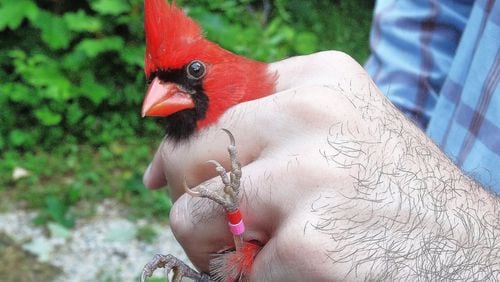Shortly after dawn one day last week, Smithsonian scientist Clay Graham gingerly removed a bright red male cardinal from a nylon “mist net” he had just set up in the backyard of a home near Fairburn.
He carefully placed the bird in a cotton bag and carried it to the front porch where he quickly weighed it, checked its feathers and did other exams. He also drew a drop of blood for later testing.
Then from his equipment box he picked up some tiny bands to attach to the bird’s legs. “I’ll do pink over red,” he said. With special pliers he attached a tiny pink band and then a red band on the left leg.
On the other leg he attached an aluminum band etched with a number that will be unique to that bird. The number will identify the bird; the color bands will make it easier for the homeowners, Kathleen Leilani and John Little, to spot the bird and track it in their yard.
All finished, Graham let go of the banded bird and, poof, it was gone.
During the next hour he performed the same tasks on a Carolina wren and two Carolina chickadees. Now, Leilani and Little will keep an eye out for the banded birds and jot down dates, times and other observations when they spy the birds. The data will be submitted to the Smithsonian’s Migratory Bird Center in Washington.
It’s all part of the center’s nationwide Neighborhood Nestwatch program, a citizen science project that helps homeowners learn more about backyard birds while collecting valuable data on how the birds are faring in urban environments. Residents in several cities are participating.
The program focuses on 10 bird species common in all of the cities — a sample the Smithsonian believes will reflect the health of the entire bird population.
Graham wrapped up this spring’s banding effort in Atlanta last week. Since 2014, when the program began in Atlanta (in partnership with Fernbank Museum of Natural History) birds at nearly 100 homes have been banded and are now being tracked.
IN THE SKY: From David Dundee, Tellus Science Museum astronomer: The moon, a thin crescent this weekend, will “grow” to first quarter by next weekend. Mercury and Venus are low in the east just before dawn. Jupiter is high in the east, and Saturn rises in the east, around sunset.






